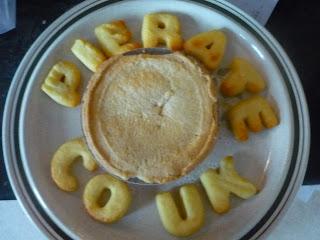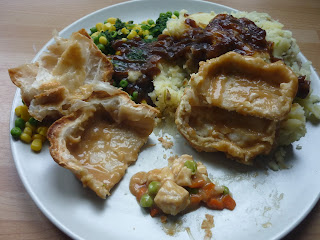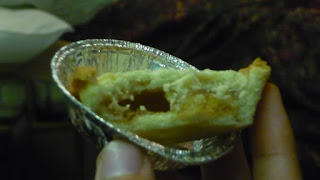The Seven Cs
1. Colour
What colour is the pastry? Is it a nice golden brown? Does it look a bit anaemic? Does it look a bit fake? To score highly in this category, candidate pies need to have a rich caramel golden brown pastry, with a similar tonality to that of golden pine. This category is ideally scored at the stage immediately prior to breaking open the pastry crust. If the pie requires cooking, then it should be cooked before scoring this category. Often, a Pierate review will include photographic evidence of the pie immediately prior to consumption – something which serves a dual purpose. The photograph not only helps the reader to appreciate the pie’s appearance, but also serves as a reminder to the reviewing Pierateer of the colour of the pie - an observation that is occasionally missed due to the fact that, when faced with a pie, a Pierateer will most often immediately consume it.
 |
| Pierate example of GOOD Colour |
 |
| Pierate example of BAD Colour |
 |
| Pierate example of BAD Colour |
2. Consistency
'Consistency’ refers to the viscosity or texture of the liquid contents of the pie. To score highly in this category, candidate pies should contain a gravy that is rich and thick. If the pie is a sweet pie, then the fruit should be adequately softened with a delicate jammy texture. Pies can score poorly if the consistency of the gravy is too runny and tastes insipid, or if the fruit is too hard. Equally, however, if the gravy is too thick such that it detracts from the overall Pierate Index of Enjoyability, then pies will gain low marks in this category for being too stodgy.
It also refers to the consistency of the quality of the pies across the set of pies (if, for example, the pie comes in a box of six) and indeed the consistency of the quality throughout the pie itself. Do all the separate parts of the pie work well together? Does the filling compliment the pastry? It's no good just having a great first bite and then being disappointed by the product as a whole!
Obviously there will be a variation between different pies which are the same brand/flavour. The Pierateers will adjust the score of a pie if future pies consumed are significantly different to that initially reviewed. If it is considered that the standard of a pie has changed for good (e.g. new recipe) then the pie may be re-reviewed entirely.
"It's no good just having a great first bite and then being disappointed by the rest!"
|
3. Capacity
This is a category for which, like Colour, photographic evidence is also collected. The capacity relates to the ratios of Air:Filling and Crust:Filling. While we accept some pies do contain air due to pastry lids rising during baking and so on, the pie can score higher in this category if there is a greater proportion of filling to air. Note that this category is very important, and pies have scored very poorly in the past (for example, Delissia “Air-pple” pies and Tesco Everyday Value Beef and Onion pie) for scrimping on the filling. While not being the case of a pass/fail category, candidate pies that score poorly on capacity will have to score exceptionally on the other six Cs to regain something that bears resemblance to a respectable score. The Crust:Filling ratio is somewhat less important than Air:Filling, but candidate pies must have a crust that encases the entire pie in order to score highly. Too much crust can also reduce the Pierate Index of Enjoyability by making the pie too dry or stodgy. There is currently no set ratio, but Pierateers will be able to judge the satisfactory nature of the ratio on a case by case basis. Since puff-pastry is thicker but lighter than shortcrust, it would be unfair to impose a standardized ideal Crust:Filling ratio across the board.
"The capacity relates to the ratios of Air:Filling and Crust:Filling."
|
 |
| Where's the air?! Pierate example of GOOD Capacity |
 |
| Not very filling... Pierate example of BAD Capacity |
 |
| Can I buy some air please?! Pierate example of BAD Capacity |
4. Chewiness
This category most relates to, but is not exclusively restricted to, meat pies. High scoring pies in this category will contain meat that is tender and melts-in-the-mouth. The chewiness of the pie crust is also taken into account here. Purveyors of vegetarian and sweet pies should also be aware that the chewiness of vegetables and/or fruit will also be accounted for, although this is obviously normally less of an issue.
Did you know?!
Pierateer SJL attempted to rate houses he was looking to rent based on the Seven Cs, which worked quite well as a house rating system until he got to Chewiness... |
5. Cheapness
Obviously, there will be a negative correlation between expense and score in this category - the Pierateers never like to get ripped off when buying pies! However, the Pierateers are generally quite sympathetic when it comes to price, especially in a restaurant, since they understand that the proprietor of such an establishment also needs to earn a crust (no pun intended). It would be unfair to downgrade an independent pie-maker simply because they are unable to compete with larger corporations on price, and Pierate wants to encourage diversity in the pie market. That said, a pie must offer good value for money to score highly.
"a pie must offer good value for money to score highly"
|
6. Content
This category relates to the composition of the filling. The quality of the ingredients should be noticeably high and novelty flavours will tend to score highly provided they taste good. Noteworthy novelty pie flavours include the infamous Popcorn Pie attempt by the Pierateers. A high-quality content is essential for a high scoring pie, and innovation is very much encouraged. British meat, vegetables and fruit, along with words like “organic”, "local" and “free range” add to the wholesome character of the pie, and would score highly.
7. Condition
The final C is the condition which the pie is received in. Generally pies score well in this category - after all, presentation is key in food reviewing in general - and even if the pie is a complete disaster elsewhere, it can at least pick up a few points from being presented neatly and attractively. If a pie in a restaurant is served burnt, for example, this will of course detract from the score in this category. If the pie is purchased in a shop, any evidence of the pie having been mishandled will mean the pie scores poorly. Similarly if there are more intentional issues with the condition - such as the creation of a gaping big hole in the pie lid, for some unbeknown reason - these will certainly be noted down.
 |
| Pierate example of GOOD Condition |
 |
| Do I want to see my filling yet?! And in a bowl?! No!!! Pierate example of BAD Condition |
The final score is then calculated by adding together the score out of 7 for each of the seven categories and then dividing by seven, thus giving a total score out of 7!
Now that you've seen how we rate pies, check out our Pierate Pie Rankings to see what pie ratings we've given or find pies rated alongside those of a similar flavour.
Make sure you Follow @pierateers
and let us know your thoughts!
|
Subscribe to:
Posts (Atom)

No comments:
Post a Comment
Thanks for getting in touch with the Pierateers!